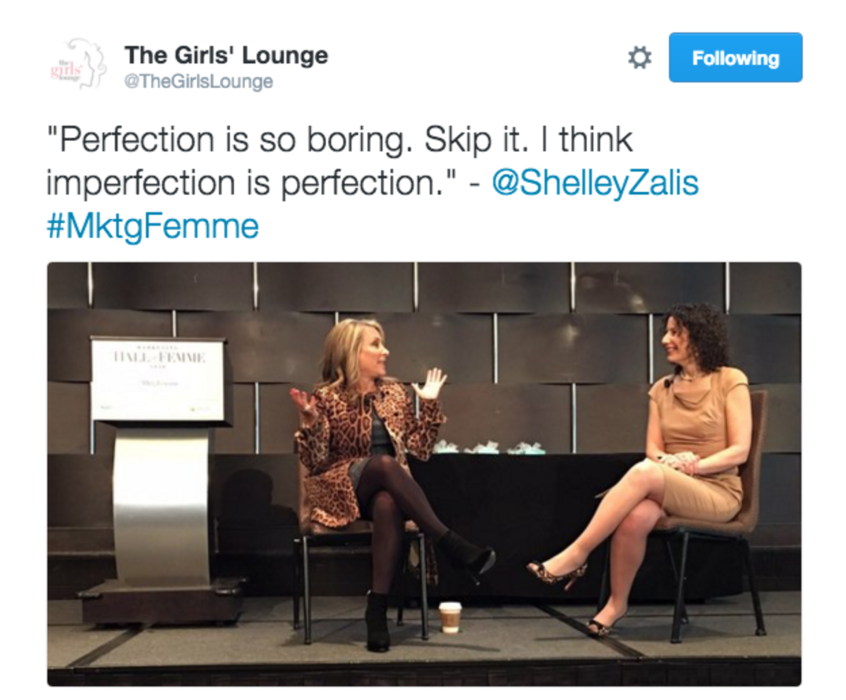Five years ago Shelley Zalis was walking the clogged aisles of the Consumer Electronics show—clogged with men, for the most part—and feeling alone. She called a woman she knew and asked if she’d walk with her. Her friends called friends and they called other women and, suddenly 50 strong, the formerly lonely ladies had become a posse commanding the floor of the Las Vegas Convention Center. “Two things happened,” said Zalis during her keynote at Direct Marketing News’ 2016 Marketing Hall of Femme Leadership Summit and Awards in New York today. “One, all the guys were like, what the f–k? And the second was this feeling that we had this power of the pack and could accomplish anything.”
The next day, Zalis’s posse grew to 100, then to 150 on day three. They decided to meet afterwards to trade notes. Zalis secured the penthouse suite in her hotel to handle the crowd. The Girls’ Lounge was born. Since then, Girls’ Lounges have been established at more than 40 conferences and trade shows. Women can sign up and hook up with new girlfriends to experience the event together. In numbers, power.
“All of a sudden you have clout because you have all these friends and people are saying, ‘Who’s she? Everybody knows her.’ And you have wisdom because we’re all working on the same problems independently. And we have impact, and change happens. We went from a moment to a movement by accident,” Zalis said.
It’s a movement that’s attracted notice at the top. This past January The Girls’ Lounge was invited to the World Economic Summit in Davos, Switzerland. Word circulated and Zalis started getting calls from women executives at blue-chip companies including Citibank and McKinsey wanting to take part.
Zalis’s contingent at WEC represented more than a score of companies. The Davos Girls’ Lounge was dubbed, “The 18%,” because only 18% of the world’s leaders are women, and Zalis’s group got down to work to leave the summit with a document to improve on that number. “Every big company does a gender equality study. It’s the default checklist item for company leaders. ‘We did a gender equality study so I’m doing my job.’ What we did at Davos was put together the gender equality studies of 23 different companies and we curated the best from all of them,” Zalis said. Key learnings were broken out into four buckets:
The wage gap: Girls’ Loungers at Davos symbolically sold chocolate bars to men for a dollar, but 77 cents to women—representative of the disparity in male-female compensation.
Unconscious bias: Focus on the fact that diversity is great for business. “Diversity is not a female issue, it’s a social and economic issue,” Zalis said.
Culture: Explore how to move from a culture of rigidity to a culture of care, “so companies can attract the best talent and not the most available talent.”
Visibility: Create an environment for people to make a difference in organizations.
Zalis has resisted requests from new members to change the name of The Girls’ Lounge to “The Women’s Lounge.” She is adamant that her organization retain its clubby, girls-night-out appeal that grew it in the first place. “I go, ‘What’s the difference?’ Because of the scarcity of jobs, most women today remain competitive, not very collaborative…. We call it ‘The Boys’ Club,’ so why not ‘The Girls’ Lounge?'”
Moreover, Zalis feels that collaboration with men is vital to the women’s workplace movement and is launching a campaign in which feminism is recast as “fem-men-ism.”
“In general, the masculine archetype is assertive, strong, bold, and opinionated. The feminine archetype is collaborative, nurturing, emotive, and storytelling. We need all of those,” Zalis said. “Men have to be included. We can’t solve it by ourselves.”








